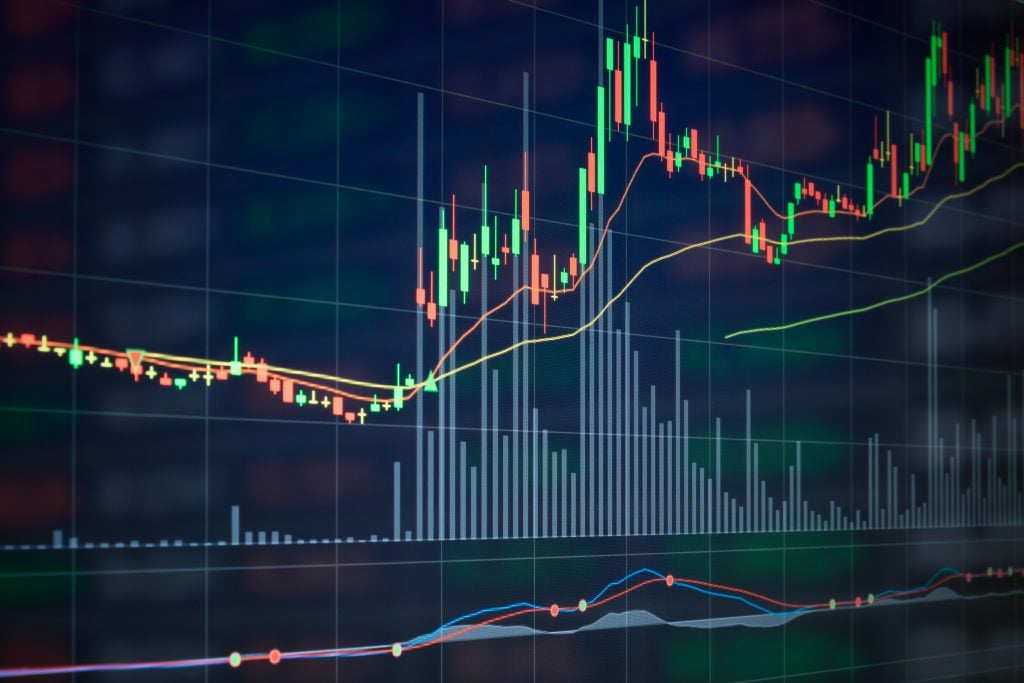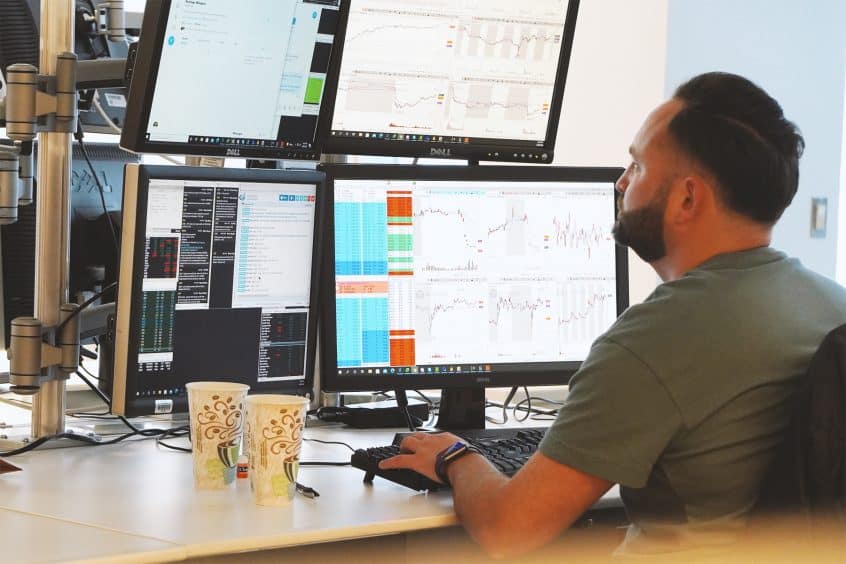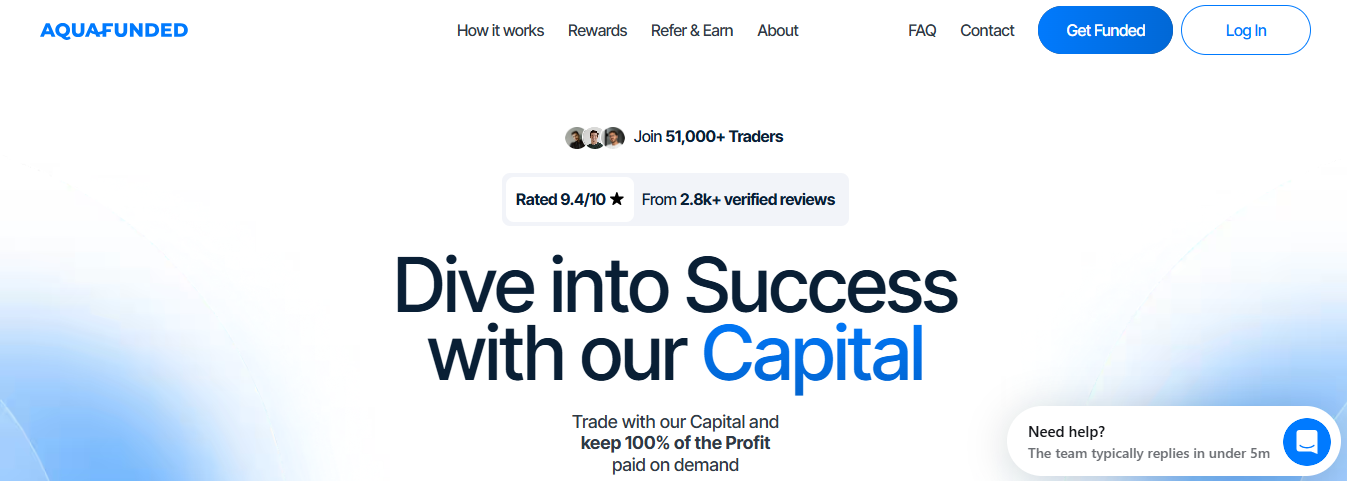CFD Leverage, Margin, and Trading Tips
Learn how CFD Leverage works with simple margin tips and practical trading guidance to manage risk and trade smarter.

When you trade Day Trading Indices, a small index swing can mean outsized gains or losses because CFD leverage magnifies exposure, making margin requirements, margin calls, and volatility real concerns for any trader. How do you pick the correct leverage ratio, size positions, place stop loss orders, and use hedging to protect capital while keeping trading costs and slippage low? This guide will break down how contract-for-difference margin trading works, explain capital efficiency and risk management in plain terms, and point you toward ways to trade professionally with funded accounts.
AquaFunded's funded trader program gives you access to risk capital, clear rules, and an evaluation path so you can prove your edge, scale position sizing without draining your own savings, and focus on execution rather than funding.
Summary
- Leverage can be a symmetric magnifier, for example, a 20 percent margin requirement equals 5x leverage, so a $12,000 position with $2,400 margin sees a $900 adverse move translate into a 37.5 percent loss of margin.
- High activity does not imply profitability. The average CFD trader makes about 50 trades per month, and over 70 percent of CFD traders lose money, which underscores the need to limit non‑edge trades.
- Broker and regulatory rules materially alter exposure; retail leverage is commonly capped at 30 to 1 for major FX pairs, and those caps change how you size cross-asset positions and manage notional risk.
- Hidden costs matter because overnight financing, swap rates, and spreads erode returns, so the article recommends testing risk settings at reduced leverage for 30 trading days to measure drawdown frequency and recovery.
- Position sizing must be dollar-risk driven; for example, set a single-trade worst-case loss target, such as 5 percent of account equity, and convert that into the correct leveraged lot size before you open any position.
- Behavioral and execution controls improve survivability. The guide provides evidence that a cohort adopting a daily stop-loss rule over 90 days halved average recovery time after drawdowns, and it recommends backtesting 200 trades and demoing for 60 days before trading live.
- This is where AquaFunded's funded traded program fits in; it addresses this by providing access to up to $400K in risk capital, predefined margin and drawdown rules, and an evaluation path that lets traders scale position sizing without draining their own savings.
What is CFD Trading?

A CFD market is where traders buy and sell contracts that mirror the price movements of assets, allowing you to gain exposure without taking ownership of the underlying asset. You enter a position with margin, use leverage to amplify exposure, and settle the difference when you close the trade, which means profit and loss track the price change rather than ownership rights.
How Does The Contract Actually Settle?
A CFD is an agreement between you and a counterparty, typically a broker, to exchange the difference in an asset’s price between entry and exit. You can go long if you expect prices to rise, or short if you expect them to fall. There is no share registration, no voting, and no dividend ownership, although adjustments for dividends and corporate actions are reflected in the contract. Because CFDs do not have a fixed expiry, positions can be rolled, and that rolling involves financing costs and spread exposure that change with market conditions.
Why Does Leverage Matter For Your Trading Plan?
Leverage lets you control a larger notional position with a much smaller margin outlay, so a 1 percent move in the underlying can equal a much larger percentage gain or loss in your account. That magnifier affects position sizing, margin requirements, stop loss placement, and the likelihood of margin calls.
Think of leverage like using a magnifying glass on price moves: it sharpens the sound signals and exaggerates the bad ones. Risk management tools, such as preset stops, position size limits, and trailing stops, are nonnegotiable when you work with high leverage, because they directly influence drawdown and survivability.
How Do Market Structure And Tools Change Your Edge?
Liquidity, spreads, slippage, and how orders are routed determine whether a trade fills where you expect. This is where technology matters, such as AI-driven pattern recognition, sentiment analysis, and algorithmic strategies, are no longer out of reach. Those tools compress research cycles and permit faster pattern discovery, but they also shift the competitive baseline. When algorithmic strategies dominate a time frame, manual techniques that worked before will need adjustment, not stubborn persistence.
What Hidden Frictions Should You Plan For?
This is where regional and macro factors bite. In some markets, Persistent concerns about electricity infrastructure, weakening business confidence, and inflationary pressures have also caused significant fluctuations in the rand. Those kinds of structural risks change funding costs, widen spreads, and create unexpected volatility spikes that hit leveraged positions hardest.
The pattern appears consistently across retail and institutional contexts. Clusters of frustration form when prices consolidate or reverse against a well-placed trade, creating the suspicion that stops are being hunted rather than simply filled by normal liquidity gaps. That feeling is exhausting, and it forces most traders to rethink stop placement, liquidity windows, and whether to trade through news.
Where Does This Leave A Practical Trader?
You must treat CFD trading as a system design problem. Define acceptable exposure and margin ratio rules up front. Choose execution windows with reliable liquidity. Account for overnight financing, swap rates, and the broker’s hedging model because those affect carry costs and realised returns. Use position sizing to convert a target dollar risk into the appropriate leveraged lot size, and build a clear plan for when to pause trading during periods of outsized volatility. These are operational rules that preserve capital more than any single predictive indicator.
That sounds like a theory, but it breaks down into predictable failure modes: position sizing that ignores margin calls, stops set too tight during illiquid periods, and overreliance on a single strategy when algorithmic flows shift. If you accept the familiar approach most traders use, you get the familiar hidden cost: capital erosion under stress. Solutions like structured risk controls and pre-trade checks reduce those failure modes by automatically enforcing margin discipline and execution rules.
That clarity is necessary because what seems like a simple contract can become surprisingly personal the moment real money and leverage are involved.
That sounds like the end of the story, but the real trade-offs are messier than most traders expect.
Related Reading
- What Is Considered a High VIX
- What Is a Trading Session
- What Is Support and Resistance in Trading
- What Is a Stock Market Index
- How to Trade S&P 500 Futures
- How Is the Dow Jones Calculated
- Trading the DAX
- CFD Indices
- Asset Class Correlation
Benefits of CFD Trading

CFD trading gives you three practical advantages that change how you allocate capital, manage risk, and pursue opportunities, all without owning the underlying asset. Each benefit shifts the trading game from buying shares to more precisely controlling exposure, which is why many active traders prefer CFDs for tactical moves and short-term strategies.
1. Why Do Cfds Avoid Stamp Duty, And What Does That Mean For You?
Because you never take physical ownership of the underlying instrument, CFD trades usually do not attract stamp duty, which lowers transaction friction compared with traditional share purchases. That can matter when you trade frequently or scale position rotation across many tickers, since smaller fixed costs add up into a material drag on returns. Tax treatment varies by jurisdiction and personal circumstance, so treat the lack of stamp duty as a structural advantage, not an after-tax guarantee.
2. How Can You Profit When Markets Fall As Well As When They Rise?
CFDs let you open short positions as easily as long ones, so you can attempt to capture value from downtrends or hedge exposure during volatile periods. Shorting with CFDs becomes a tactical tool: you can protect a long portfolio in a squeeze, express a view on weakening sectors, or pair trades to reduce net market exposure while keeping directional risk limited. This flexibility turns market direction into an opportunity rather than a one-sided bet.
3. How Does Leveraged Margin Make Your Capital More Efficient?
Trading on margin means you commit only a fraction of a position’s notional value, which frees capital for other trades or risk buffers while expanding your adequate exposure. For example, to control the equivalent of 10,000 telecom share CFDs at a $1.50 price, you might only need to post a 20 percent margin, so a $15,000 notional position requires a $3,000 margin deposit plus any commission and financing. That leverage amplifies returns and losses, so disciplined position sizing, stop placement, and routine checks on margin utilisation are essential to survive drawdowns and margin calls.
What Hidden Operational Shifts Should Traders Expect As They Use These Benefits?
Most traders treat margin as simply a way to boost buying power, because it is familiar and straightforward. Over time, that mindset produces stretched accounts and reactive risk management when markets swing, because larger notional exposure magnifies funding costs, overnight financing, and slippage.
Platforms and programs such as funded-traded programs help by providing more explicit funding rules, capped drawdown mechanics, and transparent margin calls, thereby reducing operational friction and allowing traders to focus on strategy execution rather than emergency financing.
How Do Technology And External Policy Change The Advantages Of CFDs?
Trading edge now includes execution quality and signal processing as much as position choice, because AI-driven pattern recognition, sentiment analysis, and algorithmic strategies are no longer out of reach.
Also, regional fiscal adjustments can alter the net benefit of CFD mechanics; for example, in South Africa, actions such as VAT adjustments and other budgetary reforms add to the complexity. Those shifts change funding costs, execution windows, and how you size positions, so integrate policy and tech risk into your routine trade plan.
Practical Checklist To Apply These Benefits Without Overreaching
- Convert a target-dollar risk to a levered lot size before you open a position, then validate the margin cushion for worst-case moves.
- Monitor overnight financing and commission drag as active costs that erode short-term strategies.
- Treat short positions as active risk with explicit stop and liquidity windows, rather than passive mirror bets.
- Use signal filters or automation to preserve human oversight when algorithmic flows dominate an intraday timeframe.
Turn your trading skills into substantial profits without risking your own capital. AquaFunded gives you access to accounts up to $400K with the most flexible trading conditions in the industry, no time limits, easy-to-achieve profit targets, and up to 100% profit split. Join their funded trading program to get instant funding or prove your skills through customizable challenge paths and keep up to 100% of what you earn.
That advantage looks straightforward now, but the way leverage, margin, and funding interact under stress is where the real surprises appear.
CFD Leverage and Margin

Leverage in CFDs is the multiplier that lets you control a larger exposure with a smaller deposit, and margin is the portion of the notional position you must post. It magnifies both gains and losses, so position size, margin cushion, and stop placement become the controls that determine whether leverage helps you or destroys you.
1. Margin And Leverage, Simply Explained
If a CFD margin requirement is 20 percent, your effective leverage is five times, because leverage equals one divided by the margin rate, so 1 ÷ 0.20 = 5. Practically, that means you only need to put down one-fifth of the trade value while the broker fronts the rest of the exposure.
2. Clear Numerical Example Using A $12,000 Position
You, or any trader, can compare two ways to get the same exposure. An unleveraged buyer pays the full $12,000. A CFD trader using 5x leverage posts $2,400 in margin, which provides the same market exposure as a $12,000 position. That difference in upfront capital is where the math that follows becomes crucial.
3. How A $900 Move Translates To Real Account Impact
A $900 adverse move on a $12,000 holding is 7.5 percent of the full position. For the CFD trader who posted a $2,400 margin, that same $900 swing equals a 37.5 percent loss of the margin, because 900 ÷ 2400 = 0.375. The flip side is identical: a favorable $900 move produces a 37.5 percent return on the margin. The magnifier is symmetric.
4. What This Means For Risk, Position Sizing, And Survivability
Leverage changes how you think about absolute dollar risk. With margin trading, you must convert the dollar risk you are willing to accept into a position size that keeps the worst-case drawdown within your comfort zone and prevents margin calls. If you want to limit a single-trade worst-case loss to, say, 5 percent of your account, you must set the position size and stop distance so that the leveraged PnL at that stop equals 5 percent of your equity.
5. Broker Rules, Caps, And Real-World Constraints
Retail leverage limits vary by product and regulatory regime, and some markets impose hard caps. According to EBC Financial Group (2025), "Retail leverage is capped, commonly up to 30 to 1 for major FX pairs." That cap matters because it sets the maximum notional exposure available without moving into different account types or jurisdictions, and it changes how you size cross-asset trades.
6. Why small price moves can blow up a margin account
Because margin expresses exposure relative to posted capital, small moves in the underlying can produce significant percentage changes in your margin balance; this is precisely what EBC Financial Group (2025) says: "A one percent move in the underlying can translate to a much larger percentage move on your margin.” In practical terms, that means intraday volatility, slippage, and news spikes become the real enemies of leveraged accounts, not abstract market direction.
7. Operational Failure Modes You Must Plan For
This pattern appears across retail, prop, and funded accounts: traders tighten stops to control losses, intraday noise hits those stops, and margin consumption spikes, forcing rapid de-risking or forced liquidation. The emotional effect is draining; it is exhausting when one adverse swing erodes weeks of wins and leaves you scrambling to rebuild margin rather than trade deliberately.
8. Concrete Controls To Reduce Leverage Risk
Treat leverage like adjustable amplification, not a permanent upgrade. Use smaller leverage on lower-liquidity instruments, increase margin cushion around major economic releases, size positions by dollar risk per trade rather than percent margin, and verify how overnight financing and swap rates affect carry costs before holding beyond the session. Test your plan at reduced leverage for 30 trading days, and measure drawdown frequency and recovery time before stepping up.
9. How Product Design Can Change The Stress Of Margin Trading
Most traders use margin because it seems efficient, and that approach works early on. As positions scale and volatility creeps in, the familiar method creates sudden operational friction: margin calls, forced reductions, and stops executed at worse prices than planned. Platforms like funded trading programs provide clearer funding rules, explicit drawdown caps, and predictable margin mechanics, allowing traders to focus on execution rather than emergency financing.
Turn your trading skills into substantial profits without risking your own capital. AquaFunded gives you access to accounts up to $400K with the most flexible trading conditions in the industry - no time limits, easy-to-achieve profit targets, and up to 100% profit split; join their funded trading program to get instant funding or prove your skills through customizable challenge paths and keep up to 100% of what you earn.
That simple math looks tidy until market noise and time pressure expose the one mistake that ruins most leveraged traders.
11 Tips to Trade in CFD Markets

You can trade CFDs effectively only by combining honest self-assessment with disciplined, repeatable habits and the right execution pathways. Below, I give a numbered, practical playbook that builds on earlier sections and adds fresh, actionable techniques for each item you asked for.
1. Use AquaFunded As A Leverage-Neutral Path To Scale
Treat funded programs as a way to scale skill, not a shortcut to bigger risks. When you qualify, Aqua Funded gives access to accounts up to $400K, instant funding options, flexible challenge routes, and profit splits up to 100 percent with a 48-hour payment guarantee. Use the program to lock in consistent sizing rules: trade only a fixed-dollar risk per position, maintain a minimum buffer above the maintenance margin, and test new ideas on the funded account, with a strict journal entry for each trade. That structure turns occasional wins into a repeatable edge, while the program’s customizable paths let you prove skill without eroding personal capital.
2. Be Brutally Honest With Your Temperament And Constraints
The first question is practical, not philosophical: can you sit through losses without deviating from the plan, and do you have the available time to manage intraday exposures? After coaching traders for 12 months, the pattern was clear: those who overestimate their emotional bandwidth underprice drawdown risk and burn accounts faster than skill decays. If you answer no to either time or emotional readiness, shrink trade frequency, widen stops, and adopt smaller position sizes until your behavior matches your rules.
3. Do The Homework Before You Trade Live
Keep a deliberate learning log with milestones, not vague reading lists. Set three measurable goals for your study phase, for example: backtest one simple trend-following system for 200 trades, demo it for 60 calendar days with the identical risk settings you will use live, and target a maximum simulated drawdown of 10 percent. When those goals are clear, move to a low-risk live test. This converts education into proven competence rather than mere studying.
4. Focus On A Single Market Until You Master Its Microstructure
Pick one index or sector and treat it like an apprenticeship for 90 days, recording order fills, slippage, session volatility, and the hours when liquidity thins. That metric set tells you when to trade and when to avoid the market. The faster you learn the idiosyncrasies of one instrument, the less noise will hijack your stops and decision-making.
5. Protect Capital Through Strict Risk Rules
Translate acceptable account drawdown into per-trade dollar risk and enforce it mechanically. Use pre-trade checks: position size, worst-case slippage, stop location relative to market structure, and margin cushion after the trade. If a chain of trades exceeds a preset daily loss, stop trading for the day. This makes risk control a habit, not a hope.
6. Why Programs Like Aqua Funded Matter Here
Most traders grind through small accounts because it feels familiar and requires no new financing, but that approach forces them to change risk behaviors as they scale, which creates inconsistent results. As account needs grow, execution and psychological frictions compound, eroding performance. Platforms such as AquaFunded provide a predictable funding path and standardized risk rules that let traders iterate on strategy without the financing scramble, shortening the experimentation cycle while preserving discipline.
7. Use Demo Accounts As A Behavioral Gym, Not A Playground
When you practice, force the same constraints you will face live: identical position sizing, identical leverage, identical trading hours, and the same stop rules. Treat every demo session as a graded exam with one metric for promotion, for example, net profitable weeks over a 12-week rolling window. That prevents the common mistake of demo overfitting and bridges the gap between simulation and cash.
8. Leverage Trading Tools Intentionally, Not Compulsively
Pick two analytical tools that directly inform entries and exits, and master them. For example, build a short checklist that you run before every trade: trend confirmation, liquidity check, correlation screen, and execution plan. Automate the mundane checks, but keep human judgment for contextual calls. This reduces analysis paralysis and limits exposure to indicator noise.
9. Diversify Risk Across Strategies, Not Just Assets
Rather than holding many unrelated small bets, combine strategies that perform differently under the same market conditions, for example, a momentum entry plus a volatility mean-reversion hedge. That approach reduces the chance that a single regime shift wipes out your account. Keep correlation logs so you can spot when seemingly different trades actually move together.
10. Trade With The Trend When Odds Favor Continuation
Prefer confirmations that show momentum in sync across multiple timeframes. Use a clean trailing-stop method to ride winners and reduce the urge to take profits too early. If you find you exit winners habitually, test a modest trailing parameter change in the demo for 60 days and measure the change in average win size and win rate.
11. Close Trades Decisively And Document The Reasoning
Set rules for exits before you open a position, then enforce them. If you move a stop to "let it breathe," make a post-trade note explaining the rule change and the evidence for it. That habit creates a searchable record that turns emotional improvisation into repeatable choice.
12. Log Everything And Review With A Ruthless Lens
Record entries, exits, trade rationale, emotional state, and execution quality. Every two weeks, run a performance review with at least one specific metric, for example, average reward to risk on winners versus losers, and a behavioral metric, such as frequency of rule breaches. After three months, you must be able to point to one change driven by the log and show measurable improvement.
13. Merchant’s Warning About Activity And Expectations
Accept that many traders struggle to translate activity into profit, and that high-frequency tinkering often masks poor edge definition, according to the Retail Technology Innovation Hub 2025-08-14, "The average CFD trader makes 50 trades per month", which explains why limiting non‑edge trades improves survivability and clarity of learning. Also recognize the sobering reality documented by Retail Technology Innovation Hub, 2025-08-14, "Over 70% of CFD traders lose money", and use that as motivation to design controls that reduce behavioral drift.
14. Address The Emotional Friction Head-On
It is exhausting when execution rules collapse under stress. When we implemented a simple daily stop-loss rule for a cohort over 90 days, their average recovery time after a drawdown halved because they stopped compounding mistakes. Build those stopping rules into your plan, test them under demo stress, and make them nonnegotiable.
15. Small Analogies That Stick
Think of your trading plan like a ship’s navigation system: charts, a compass, waypoints, and an anchor. The market is the sea. The navigation system does not promise safe passage, but it prevents the captain from steering into rocks when the waves get big.
Related Reading
- Where to Place Stop Loss
- Position Size Formula
- Scalping vs Day Trading
- What Is Index Pricing
- Volatility Indicator MT4
- What Are the Advantages of CFD Trading Over Normal Trading
- How to Profit From CFD Trading
- What Is a Fair Value Gap in Trading
- How to Calculate Stock Volatility
- Difference Between Nasdaq and S&P
- FTSE vs MSCI
Join Our Funded Trading Program Today - Trade with our Capital and Keep up to 100% of the Profit

Please consider AquaFunded if you want to scale your index day trading without risking your own capital, because running real trades under firm position sizing, margin cushion, and leverage rules is the fastest way to learn what endures under pressure. Take advantage of offers to lower the barrier, then let consistent execution and tighter risk controls decide when to scale.
Related Reading
• Dow Jones Index vs S&P 500
• CFD Market Hours
• CFD Leverage
• NFP Trading
• Spot Trading vs Futures Trading
• Breakout Trading Strategy
• Gap Fill Strategy
• Swing Trading Patterns
• FTSE 100 vs S&P 500


